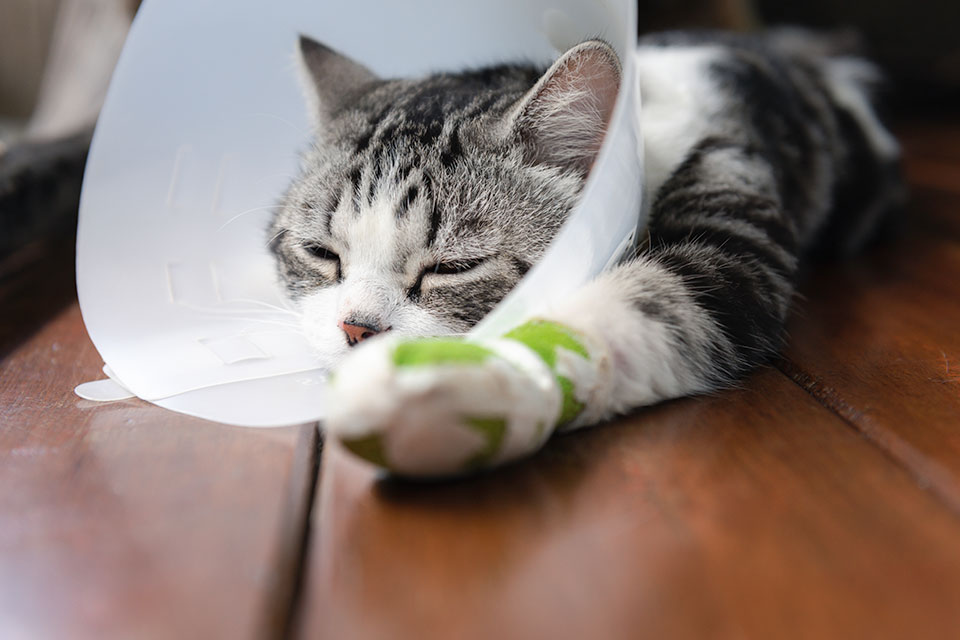Is Laser Declawing Better?

Declawing a cat involves surgery to remove the last bone in each toe, and it's often done with a scalpel blade. However, some veterinary practices use a laser for declawing. Often, people claim laser declawing is more humane than scalpel declawing because it is not as traumatic to the tissues, which should lead to less pain.
But is this true?
No matter how a declaw procedure is performed, it is still the amputation of the distal phalanx (the part of the toe up to the first joint) on each toe. The reason an amputation must be performed during a declaw is because the germinal tissue, which is responsible for the formation of the claw, resides in that distal phalanx. Simply cutting or removing the claw alone will not result in a permanently declawed cat. The claw will simply grow back from that germinal tissue. Amputation of the end of each digit must be performed for a permanent declaw to occur.
Declaw Surgery Is Painful
No matter how the surgery is performed, declawing is excruciatingly painful for cats. It is ten separate amputations—or eighteen if all four paws are done. Cats don't walk on the balls of their feet like humans. They walk up on their toes (digitigrade). Therefore, after a declaw surgery, a cat must walk directly on all those amputation sites.
Not only is declawing painful in the short-term, but it can also cause a cat chronic pain due to the formation of arthritis or the deformation and breakdown of other joints in the paw as a result of an altered walking position.
Declawing Changes a Cat's Walking Position
Cats use their claws for more than scratching. They are also crucial for traction and balance. They're part of the reason why cats are known for their remarkable agility, coordination, and balance.
Normally, cats can climb, jump, run, maneuver, and balance with ease. But when their claws and the last bones on their toes are removed, those abilities can be seriously negatively affected. Cats may be prone to injuries from falls, or they may simply stop being as athletic as they were before.
Declawing Is Traumatic for Cats
The pain associated with declaw surgery is traumatic for cats. The surgery is also psychologically traumatic, as the cat realizes it doesn't have its claws for getting away from danger or defending themselves. This can cause fear, anxiety, and depression that often leads to behavioral issues.
Because cats use their claws as a natural defense mechanism and to mark their territory, removing them can make them feel vulnerable and stressed. That can lead to changes in their behavior such as:
- Increased aggression
- Biting
- Avoiding people and other pets
- Inappropriate elimination
Yes, though it may seem like two separate issues, cats may begin to avoid their litter box after being declawed. This is because, during the recovery time, balancing on sore paws and using them to dig around in the litter can lead to extra pain. The kitty may associate that extra pain with the litter box and begin to avoid it. This will inevitably lead to frustration on the part of the owner but also on the part of the cat, as they are fastidious by nature.
Alternatives to Laser Declawing
There are many ways you can manage your cat's claws without resorting to having them declawed.
Here are some alternatives to declawing:
- Trimming the claws regularly. When you trim the hooks off the ends of your cat's claws weekly, it can help decrease damage done by scratching because those hooks aren't getting caught in items and tearing them. Most cats can become comfortable with claw trimming when it's done routinely and in a way that makes it a positive experience for them. Check out this article for more information: "How to Trim Your Cat's Claws."
- Using Soft Paws. Soft Paws are vinyl claw caps. They do not hurt to put on or for the cat to wear or cause the kitty to be unable to retract their claws. Instead, they provide a soft surface over the claw while still allowing your cat to scratch normally. Learn more here: "Soft Paws: The Quick and Cheap Declawing Alternative."
- Employing Scratching Posts. The proper use and positioning of good quality scratching posts can eliminate or avoid your cat's inappropriate scratching. Cats scratch for many reasons, so it's crucial that they have a good outlet for doing so. Providing proper posts can not only save your belongings from cat scratching damage but also improve your cat's quality of life.
- Using deterrents. You can use deterrents in areas where your cat is engaging in unwanted scratching. Double-sided tape can work great because cats don't like when it sticks to their paws. Bitter apple sprays (that are safe for cats and after checking that they don't negatively affect your surface) can sometimes help because cats like to stay clean and won't want to lick these substances off their paws.
- Feliway. Feliway is a substance that mimics the calming pheromones mother cats emit to calm their kittens. Using it in your home can help relieve your cat's stress, and that can often lead to a decrease in unwanted scratching activity.
Laser declawing is still declawing, with all the negative impacts on cats as scalpel declawing. It's best for a cat's short and long-term health and happiness to avoid it.



